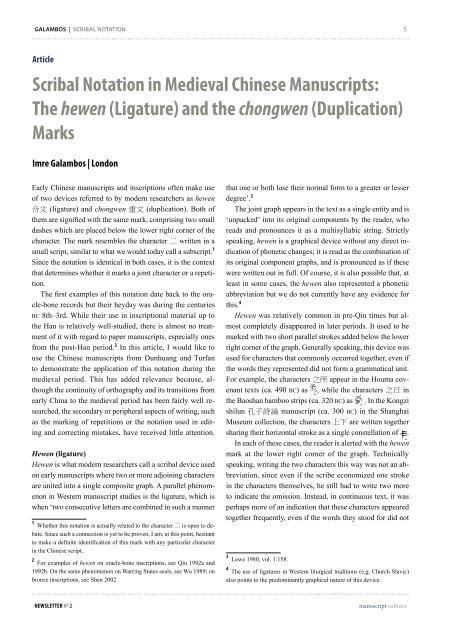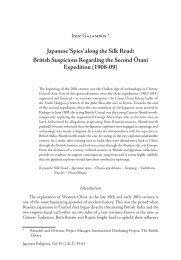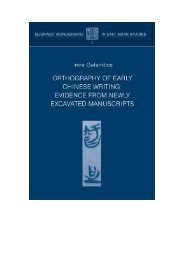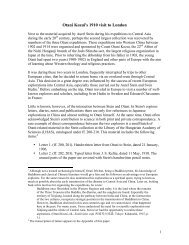Scribal Notation in Medieval Chinese Manuscripts: The hewen ...
Scribal Notation in Medieval Chinese Manuscripts: The hewen ...
Scribal Notation in Medieval Chinese Manuscripts: The hewen ...
You also want an ePaper? Increase the reach of your titles
YUMPU automatically turns print PDFs into web optimized ePapers that Google loves.
GALAMBOS | SCRIBAL NOTATION5Article<strong>Scribal</strong> <strong>Notation</strong> <strong>in</strong> <strong>Medieval</strong> Ch<strong>in</strong>ese <strong>Manuscripts</strong>:<strong>The</strong> <strong>hewen</strong> (Ligature) and the chongwen (Duplication)MarksImre Galambos | LondonEarly Ch<strong>in</strong>ese manuscripts and <strong>in</strong>scriptions often make useof two devices referred to by modern researchers as <strong>hewen</strong> (ligature) and chongwen (duplication). Both ofdashes which are placed below the lower right corner of thecharacter. <strong>The</strong> mark resembles the character written <strong>in</strong> asmall script, similar to what we would today call a subscript. 1S<strong>in</strong>ce the notation is identical <strong>in</strong> both cases, it is the contextthat determ<strong>in</strong>es whether it marks a jo<strong>in</strong>t character or a repetition.cle-bonerecords but their heyday was dur<strong>in</strong>g the centuriesBC 8th–3rd. While their use <strong>in</strong> <strong>in</strong>scriptional material up tothe Han is relatively well-studied, there is almost no treatmentof it with regard to paper manuscripts, especially onesfrom the post-Han period. 2 In this article, I would like touse the Ch<strong>in</strong>ese manuscripts from Dunhuang and Turfanto demonstrate the application of this notation dur<strong>in</strong>g themedieval period. This has added relevance because, althoughthe cont<strong>in</strong>uity of orthography and its transitions fromearly Ch<strong>in</strong>a to the medieval period has been fairly well researched,the secondary or peripheral aspects of writ<strong>in</strong>g, suchas the mark<strong>in</strong>g of repetitions or the notation used <strong>in</strong> edit<strong>in</strong>gand correct<strong>in</strong>g mistakes, have received little attention.Hewen (ligature)Hewen is what modern researchers call a scribal device usedon early manuscripts where two or more adjo<strong>in</strong><strong>in</strong>g charactersare united <strong>in</strong>to a s<strong>in</strong>gle composite graph. A parallel phenomenon<strong>in</strong> Western manuscript studies is the ligature, which iswhen two consecutive letters are comb<strong>in</strong>ed <strong>in</strong> such a manner1 Whether this notation is actually related to the character is open to debate.S<strong>in</strong>ce such a connection is yet to be proven, I am, at this po<strong>in</strong>t, hesitantto make a def<strong>in</strong>ite identification of this mark with any particular character<strong>in</strong> the Ch<strong>in</strong>ese script.2 For examples of <strong>hewen</strong> on oracle-bone <strong>in</strong>scriptions, see Qiu 1992a and1992b. On the same phenomenon on Warr<strong>in</strong>g States seals, see Wu 1989; onbronze <strong>in</strong>scriptions, see Shen 2002.that one or both lose their normal form to a greater or lesserdegree. 3<strong>The</strong> jo<strong>in</strong>t graph appears <strong>in</strong> the text as a s<strong>in</strong>gle entity and isunpacked <strong>in</strong>to its orig<strong>in</strong>al components by the reader, whoreads and pronounces it as a multisyllabic str<strong>in</strong>g. Strictlyspeak<strong>in</strong>g, <strong>hewen</strong> is a graphical device without any direct <strong>in</strong>dicationof phonetic changes; it is read as the comb<strong>in</strong>ation ofits orig<strong>in</strong>al component graphs, and is pronounced as if thesewere written out <strong>in</strong> full. Of course, it is also possible that, atleast <strong>in</strong> some cases, the <strong>hewen</strong> also represented a phoneticabbreviation but we do not currently have any evidence forthis. 4Hewen was relatively common <strong>in</strong> pre-Q<strong>in</strong> times but almostcompletely disappeared <strong>in</strong> later periods. It used to bemarked with two short parallel strokes added below the lowerright corner of the graph. Generally speak<strong>in</strong>g, this device wasused for characters that commonly occurred together, even ifthe words they represented did not form a grammatical unit.For example, the characters appear <strong>in</strong> the Houma covenanttexts (ca. 490 BC) as , while the characters <strong>in</strong>the Baoshan bamboo strips (ca. 320 BC) as . In the Kongzishilun manuscript (ca. 300 BC) <strong>in</strong> the ShanghaiMuseum collection, the characters are written togethershar<strong>in</strong>g their horizontal stroke as a s<strong>in</strong>gle constellation of .In each of these cases, the reader is alerted with the <strong>hewen</strong>mark at the lower right corner of the graph. Technicallyspeak<strong>in</strong>g, writ<strong>in</strong>g the two characters this way was not an abbreviation,s<strong>in</strong>ce even if the scribe economized one stroke<strong>in</strong> the characters themselves, he still had to write two moreto <strong>in</strong>dicate the omission. Instead, <strong>in</strong> cont<strong>in</strong>uous text, it wasperhaps more of an <strong>in</strong>dication that these characters appearedtogether frequently, even if the words they stood for did not3 Lowe 1980, vol. 1:158.4 <strong>The</strong> use of ligatures <strong>in</strong> Western liturgical traditions (e.g. Church Slavic)also po<strong>in</strong>ts to the predom<strong>in</strong>antly graphical nature of this device.NEWSLETTER N O 2manuscript cultures
6GALAMBOS | SCRIBAL NOTATIONFig. 1: A fragment from the Houma covenant texts. Even with<strong>in</strong> this short text,the <strong>hewen</strong> with the word occurs three times, most clearly <strong>in</strong> the lastl<strong>in</strong>e as <strong>in</strong> the phrase (‘down to his descendants’). Another <strong>hewen</strong>comb<strong>in</strong>ation on the same fragment is the name of the city of Handan appear<strong>in</strong>g asFig. 2: Two sections from manuscript Or.8210/S.238, show<strong>in</strong>g the compositecharacters and the empty space left before them. On the left image we can seethe name written as a s<strong>in</strong>gle unit; and on the right one, the name form a compound. In other words, the words written by jo<strong>in</strong>tcharacters do not always form a semantic unit and their relationshipis simply that of collocations.An <strong>in</strong>terest<strong>in</strong>g type of <strong>hewen</strong> was when one of the twoorig<strong>in</strong>al characters structurally already <strong>in</strong>cluded the other.For example, <strong>in</strong> the Houma covenant texts (ca. 490 BC) weoften see the form , which stood for the characters (Fig. 1). From a structural po<strong>in</strong>t of view, this was only thecharacter with the <strong>hewen</strong> sign underneath, alert<strong>in</strong>g thereader that some sort of duplication was at play. S<strong>in</strong>ce the orthographyof the character already <strong>in</strong>corporated the character as a component, was enough to represent bothof them. Examples of similar usage from the Warr<strong>in</strong>g Statesperiod are the characters written as on seals, or written as on so-called Chu manuscripts.In Western Zhou and Warr<strong>in</strong>g States periods, when theuse of <strong>hewen</strong> and chongwen was most common, the notationfor both of these devices was identical: a small double-notchsign placed underneath the lower right corner of the character.In both cases, the mark <strong>in</strong>dicated a doubl<strong>in</strong>g: either thattwo characters have been jo<strong>in</strong>ed together, or that one was tobe read twice.In medieval Ch<strong>in</strong>ese manuscript culture, the use of <strong>hewen</strong>differed markedly from that seen <strong>in</strong> pre-Q<strong>in</strong> manuscripts.-be<strong>in</strong>g grouped together. On manuscript Or.8210/S.529, aseries of letters of <strong>in</strong>troduction dated from 9th-10th centuries,the name of monks Guiwen and Dequan arejo<strong>in</strong>ed <strong>in</strong>to s<strong>in</strong>gle graphs as and , respectively. Whilethe other characters <strong>in</strong> the manuscript are dist<strong>in</strong>ctly separatedfrom each other, these names appear written togetheras s<strong>in</strong>gle entities. <strong>The</strong> obvious reason beh<strong>in</strong>d writ<strong>in</strong>g nameslike this would be to treat them as a whole, lend<strong>in</strong>g them anemblematic quality.Manuscript Or.8210/S.238 5 with a Taoist text called bearsa colophon dat<strong>in</strong>g the document to 692 AD. <strong>The</strong>re are twois the name Yuanfu written as , appear<strong>in</strong>g <strong>in</strong> thestr<strong>in</strong>g <strong>The</strong> <strong>in</strong>terest<strong>in</strong>g phenomenon is thatan empty space stands before the composite character on themanuscript, as if <strong>in</strong>dicat<strong>in</strong>g that, if not for the name taboo,part of the graph to follow would have actually been written<strong>in</strong> that space (Fig. 2). In other words, there is enough physicalspace left for unpack<strong>in</strong>g the jo<strong>in</strong>t character. <strong>The</strong> sametext has also been preserved <strong>in</strong> the Taoist Canon, only there5 All manuscripts from the Ste<strong>in</strong> collection <strong>in</strong> the British Library, beg<strong>in</strong>n<strong>in</strong>gwith ‘Or.8210’, are taken from the IDP website: http://idp.bl.uk.manuscript cultures NEWSLETTER N O 2
GALAMBOS | SCRIBAL NOTATION7the characters appear without observ<strong>in</strong>g the taboo. <strong>The</strong> secondexample with<strong>in</strong> the same manuscript is very similar. In thiscase, it is the name Y<strong>in</strong>j<strong>in</strong>g <strong>in</strong> the str<strong>in</strong>g written as . In the new character, the character isfully present but is miss<strong>in</strong>g its radical, thus <strong>in</strong> this case thefusion also <strong>in</strong>volves an abbreviation.It is clear from the context that, <strong>in</strong> this case, the compositecharacter was used as a means of observ<strong>in</strong>g a name taboo fordeceased masters. This was very similar <strong>in</strong> nature to the nametaboo of imperial names dur<strong>in</strong>g a given dynasty. <strong>The</strong> characters and <strong>in</strong> the Tang dynasty, for example, were rout<strong>in</strong>elywritten without their last stroke due to the fact that they occurred<strong>in</strong> the personal name of Li Shim<strong>in</strong> , the founderof the dynasty. It was also a common practice to replace thesetwo characters with and writ<strong>in</strong>g more or less synonymouswords. In the case of the two composite characters seen<strong>in</strong> the Taoist manuscript Or.8210/S.238 above, the name taboowas observed by writ<strong>in</strong>g the names of the late masters togetheras s<strong>in</strong>gle units, and by leav<strong>in</strong>g an empty space before the jo<strong>in</strong>tcharacter. Needless to say that while the jo<strong>in</strong>t graphs functionas a <strong>hewen</strong>, their use and application are very unlike thoseseen on pre-Q<strong>in</strong> manuscripts. 6At the same time, there is a small number of words thatoccasionally appear <strong>in</strong> Buddhist manuscripts from Dunhuang<strong>in</strong> the form of <strong>hewen</strong>. <strong>The</strong> most common of these is the graphstand<strong>in</strong>g for the word pusa (). 7 Anotherjo<strong>in</strong>t graph is for the word puti (), written as ,or . <strong>The</strong> last form here overlaps <strong>in</strong> structure with howthe word pusa was abbreviated and can be dist<strong>in</strong>guishedonly with the help of the context. A somewhat less frequentexample of <strong>hewen</strong> <strong>in</strong> the Dunhuang material is the wordniepan () which was sometimes written as ,or . 8 Now it is apparent that all three examples are Buddhisttechnical terms and <strong>in</strong> this sense their usage is closelyrem<strong>in</strong>iscent of Western ligatures. It is perhaps significant thateach of these three words was a transliteration of a Sanskritterm and because of this their <strong>in</strong>dividual component charactershad no semantic significance. Another important aspect is thatthese forms never appear <strong>in</strong> sutras but only <strong>in</strong> non-canonical6 It is also worth mention<strong>in</strong>g here the Daoist tradition of comb<strong>in</strong><strong>in</strong>g characters<strong>in</strong>to elaborate talismans (fu ). Such graphic constellations, however, arestrictly speak<strong>in</strong>g not part of writ<strong>in</strong>g habits, and shall not be considered here.7 <strong>The</strong> follow<strong>in</strong>g examples are from Huang 2005.8 Interest<strong>in</strong>gly, the late 10th century dictionary ,compiled on the basis of Tang-Song Buddhist manuscripts, identified these<strong>hewen</strong> graphs as consist<strong>in</strong>g of two separate sounds. For the graph , forexample, it says, ‘pronounced mang, mean<strong>in</strong>g the abundant growth of vegetation;also pronounced as the two characters pusa’ , reveal<strong>in</strong>g that it identifies the same graph both as avariant form of the character and as a <strong>hewen</strong> for the word pusa.texts, such as commentaries or transformation texts. 9 Thisshows that the <strong>hewen</strong> forms were not accepted as standardforms and were banned from canonical usage.Beside the above examples, there are also the cases of thegraphs (twenty), (thirty), and (forty) which werecommonly used <strong>in</strong> medieval Ch<strong>in</strong>ese manuscripts, althoughnot limited to them. While some researchers believe thatthese were read as two-syllable words <strong>in</strong> medieval times, andthus represented true cases of <strong>hewen</strong>, there is also evidenceto the contrary. For example, the celebrated Song dynastyscholar Hong Mai (1123–1202) described how, <strong>in</strong> transmittedsources, the odes on the First Emperor’s steles werecomposed <strong>in</strong> four-character units, except when a date was). 10 When a fragmentof one of the steles was discovered, it became clear thatthe numbers <strong>in</strong> the dates had orig<strong>in</strong>ally been written with thejo<strong>in</strong>t form (e.g. ) and thus did not violate the tetrasyllabicpr<strong>in</strong>ciple. Of course, this also means that these jo<strong>in</strong>tcharacters were read as a s<strong>in</strong>gle syllable, at least dur<strong>in</strong>g theQ<strong>in</strong>, and because of this they should be considered characters<strong>in</strong> their own right, rather than <strong>hewen</strong> comb<strong>in</strong>ations.<strong>The</strong> above cases are the types of <strong>hewen</strong> that occur <strong>in</strong> me -dieval Ch<strong>in</strong>ese manuscripts. An important difference fromearly usage is that <strong>hewen</strong> <strong>in</strong> Dunhuang and Turfan is nevermarked. Although there are many different k<strong>in</strong>ds of notationsfor repetition, deletion or <strong>in</strong>sertion of characters, it wasnot considered necessary to <strong>in</strong>dicate composite characters <strong>in</strong>writ<strong>in</strong>g. <strong>The</strong> obvious reason for this was that, <strong>in</strong> contrast withthe use of <strong>hewen</strong> <strong>in</strong> early Ch<strong>in</strong>ese manuscripts, comb<strong>in</strong>edcharacters <strong>in</strong> medieval practice made up mean<strong>in</strong>gful units(e.g. words, names). Accord<strong>in</strong>gly, there seems to be no directevolutionary connection between the use of <strong>hewen</strong> <strong>in</strong> pre-Q<strong>in</strong>and <strong>in</strong> medieval times.ChongwenIn pre-Q<strong>in</strong> manuscripts, the <strong>hewen</strong> mark was identical to thatof chongwencharacters were fused <strong>in</strong>to a s<strong>in</strong>gle unit, <strong>in</strong> the second it <strong>in</strong>dicatedthat a character or a str<strong>in</strong>g of characters was to be readtwice. <strong>The</strong> reader had to rely on the context to determ<strong>in</strong>e how<strong>hewen</strong>, thechongwen device <strong>in</strong> medieval manuscripts suggests a directconnection with the pre-Q<strong>in</strong> one. In both its function and ap-9 A similar pattern can be observed with regard to the use of the graph , anon-standard form of the character (Buddha). This form, co<strong>in</strong>cid<strong>in</strong>g withthe modern Japanese way of writ<strong>in</strong>g the same character, was never used <strong>in</strong>sutras, only <strong>in</strong> non-canonical Buddhist texts.10 Hong 1978:69–70.NEWSLETTER N O 2manuscript cultures
8GALAMBOS | SCRIBAL NOTATIONFig. 3: Section of manuscriptOr.8210/S.1547 show<strong>in</strong>g the use ofthe repetition mark. <strong>The</strong> characters <strong>in</strong> the first l<strong>in</strong>e and <strong>in</strong>the second are repeatedFig. 4: Repetition marks for multi-character chongwenA: Or.8210/S.2067 B: 80TBI:009 C: Or.8210/S.116pearance, it rema<strong>in</strong>ed practically unchanged, as abundantlymanifested <strong>in</strong> the Dunhuang and Turfan corpora.Pr<strong>in</strong>cipally speak<strong>in</strong>g, there are two k<strong>in</strong>ds of chongwen:s<strong>in</strong>gle and multiple ones. In the first type, only one characteris repeated, whereas <strong>in</strong> the latter two or more. Whilethis may seem a trivial dist<strong>in</strong>ction, the notation for these <strong>in</strong>actual usage was somewhat different. <strong>The</strong> s<strong>in</strong>gle characterrepetition is simply marked by a small mark <strong>in</strong> place ofthe second character. This mark was sometimes written asor , and probably derived from the pre-Q<strong>in</strong> chongwenmark. Nevertheless, the form is by far the most common<strong>in</strong> Dunhuang and Turfan. An important difference betweenearly and medieval usage was that, <strong>in</strong> the latter, the mark wasplaced with<strong>in</strong> the ma<strong>in</strong> text, <strong>in</strong> place of the omitted secondcharacter. In this way, the repetition mark occupied a fullcharacter space.Or.8210/S.1547, for example, is a manuscript of theChengshilun (*) dated to 512 AD.At the very end of the scroll, we f<strong>in</strong>d the follow<strong>in</strong>g two sentences(given below <strong>in</strong> modern punctuation):Such a man is like a fire burn<strong>in</strong>g the firewood: once the firewoodis exhausted, it will become ext<strong>in</strong>guished; this man isalso like this; because he receives no more, he becomes ext<strong>in</strong>guished.If he ext<strong>in</strong>guishes the three m<strong>in</strong>ds, he will atta<strong>in</strong>eternal liberation from all suffer<strong>in</strong>gs.chongwen:first the character and then a bit later the character . Ineach case, the second characte r is omitted and a mark isplaced <strong>in</strong> its stead (Fig. 3). Although the characters do notform a s<strong>in</strong>gle unit <strong>in</strong> the text grammatically (i.e. , or ) and, <strong>in</strong> a modern punctuated transcription, are separatedfrom each other by a comma or a period, this did not stop themedieval scribe from apply<strong>in</strong>g the chongwen device purelybased on their physical adjacency.In multi-character repetition, the chongwen mark is placedeither underneath the character or at its lower right corner. Anexample of the former usage is Or.8210/S.2067 (Fig. 4/A)where the characters (<strong>in</strong>describable or unspeakable)are repeated <strong>in</strong> the phrase <strong>in</strong>describable and <strong>in</strong>describablemyriads of sentient be<strong>in</strong>gs . What makesthis case different from the s<strong>in</strong>gle chongwen seen above is thatthe three characters are to be read together and only then repeatedas a str<strong>in</strong>g. At least theoretically, it would be possibleto read them repeated one by one as but thiswould produce a mean<strong>in</strong>gless str<strong>in</strong>g of characters. <strong>The</strong>refore,the context is used by the reader for disambiguation.manuscript cultures NEWSLETTER N O 2
GALAMBOS | SCRIBAL NOTATION9<strong>The</strong> other way of mark<strong>in</strong>g multi-character chongwen canbe seen on manuscript 80TBI:009 discovered <strong>in</strong> Turfan (Fig.4/B), where the device is marked with a slanted double dashunderneath the lower right corner of the character. <strong>The</strong> sectionshown on the picture conta<strong>in</strong>s two such cases: <strong>in</strong> the firstl<strong>in</strong>e, we f<strong>in</strong>d Buddha’s habitual exclamation (Excellent, excellent!’); and <strong>in</strong> the third l<strong>in</strong>e, thewords (‘monks and nuns’) arewritten with the characters marked as hav<strong>in</strong>g to be readtwice. This latter case is a wonderful example to show thatthe chongwen device is completely unrelated to the grammaticalstructure of the text and it relies solely on the physicalposition (i.e. adjacency) of characters. In other words,chongwen appears to be concerned only with characters, notwords or sentences.In addition, the doubled chongwen mark is sometimeswritten as a s<strong>in</strong>gle slanted stroke, as can be seen <strong>in</strong> manuscriptOr.8210/S.116 (Fig. 4/C), where the word niepan () is marked <strong>in</strong> this way. In this particular case,the repeated word occurs at the end of one sentence andthe beg<strong>in</strong>n<strong>in</strong>g of another: ‘This is why it is called the Great. In there is no pleasure...’ . In the first sentence, the word is actually ‘Great’is semantically not completely parallel. In this respect, thisusage is similar to that of the words (‘monks and nuns’).Look<strong>in</strong>g through concrete examples of chongwen, it is apparentthat the device was optional <strong>in</strong> medieval manuscripts.Even <strong>in</strong> documents where it occurs, there are places of oftenidentical context where it is not used and the characters are‘spelled out’ <strong>in</strong> their full form. In fact, there are fewer caseswhere chongwen is used than where it is not—it is rather anexception than the norm.REFERENCESHong Mai (1978), (Shanghai:Shanghai guji chubanshe).Huang Zheng (2005), (Shanghai: Shanghai jiaoyu chubanshe).Lowe, Elias Avery (1980), South Italian m<strong>in</strong>iscule (Roma: Edizioni di storia e letteratura).Qiu Xigui (1992a), ‘Jiaguwen zhong chongwen he <strong>hewen</strong>chongfu pianpang de shenglue’ ‘’, <strong>in</strong> Qiu Xigui, . (Beij<strong>in</strong>g:Zhonghua shuju), 141–146.–––– (1992b), ‘Zai tan jiaguwen zhong chongwen de shenglue’ ‘, <strong>in</strong> Qiu Xigui, (Beij<strong>in</strong>g: Zhonghua shuju), 147–150.Shanxi sheng wenwu gongzuo weiyuanhui (1976) (ed.), Houma mengshu (Shanghai: Wenwu).Shen, Baochun (2002), ‘Xi Zhou j<strong>in</strong>wen chongwen xianxiangtanjiu: yi “Y<strong>in</strong>xu j<strong>in</strong>wen jicheng” guilei chongwen wei li’: “”’ , 24: 307–11.Wu Zhenwu (1989), ‘Guxi <strong>hewen</strong> kao (shiba pian)’ ' 17: 268–281.X<strong>in</strong>jiang Weiwu’er Zizhiqu Tulufanxue yanjiuyuan , Wuhan daxue zhongguo san zhijiu shiji yanjiusuo (2007)(eds.), (Beij<strong>in</strong>g: Wenwu).Summary<strong>The</strong> use of <strong>hewen</strong> and chongwen devices <strong>in</strong> medieval manuscriptsis <strong>in</strong>terest<strong>in</strong>g from the po<strong>in</strong>t of view of the transmissionof scribal practices <strong>in</strong> Ch<strong>in</strong>ese history. While the <strong>hewen</strong><strong>in</strong> the medieval corpus shows no similarity to Warr<strong>in</strong>g Statesusage, chongwen rema<strong>in</strong>s a common phenomenon and ismarked <strong>in</strong> a similar way as it was fifteen hundred years earlier.This observation is significant because we do not haveany evidence that such scribal techniques would have beentaught. <strong>The</strong>y are certa<strong>in</strong>ly absent from the l<strong>in</strong>guistic treatises,dictionaries and primers describ<strong>in</strong>g some of the more obviousfeatures of the script (correct character forms, variants,etc). <strong>The</strong>refore, the analogous use of the chongwen deviceand its similar notation arguably demonstrate a direct cont<strong>in</strong>uitybetween pre-Q<strong>in</strong> and Tang-Song manuscript culture.Picture credits:Fig. 1: Trac<strong>in</strong>g from Shanxi 1976: 264.Fig. 2: International Dunhuang Project (http://idp.bl.uk),Or.8210/S.238. Copyright of the British Library.Fig. 3: International Dunhuang Project (http://idp.bl.uk),Or.8210/S.1547. Copyright of the British Library.Fig. 4: Images A and C are from International Dunhuang Project(http://idp.bl.uk), shelfmarks Or.8210/S.2067 and Or.8210/S.116.Copyright of the British Library. Image C is from the publicationX<strong>in</strong>jiang 2007: 11.NEWSLETTER N O 2manuscript cultures







